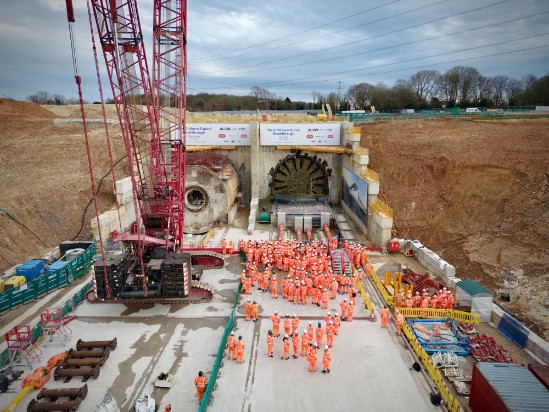The progress made to deliver HS2 is outlined today in figures showing that the majority of the deep tunnel drives and earthworks needed for the high-speed railway have now been completed.
Despite the programme’s challenges, a considerable amount of work has been carried out on the civil engineering that will lay the foundations for the 140-mile line between London and the West Midlands.
Figures show that 70 per cent of twin-bore tunnels have been excavated to date, representing 38 of the 55 miles being built for the railway. This includes the breakthrough earlier this year of the two giant machines (pictured below) used to dig the 10-mile Chiltern Tunnel – the longest and deepest on the route.
In all, five out of 12 tunnel drives have been completed. The most recent was the first of four machines being used to dig the Northolt Tunnel in north-west London, which finished its drive on December 19.
The figures show that 58 per cent of earthworks for the railway’s cuttings, embankments, stations and landscaping have been completed. It represents almost 92 million cubic metres of material moved in total so far. This includes the extensive progress made in central Birmingham to prepare for construction of the city's Curzon Street station (below).
Additionally, work has started on construction of 158 out of 227 viaducts and bridges – 70 per cent – with 13 already built. In September, HS2 completed the deck of the 2.1-mile Colne Valley Viaduct – the UK’s longest rail bridge that will carry the railway over a series of lakes and waterways on the north-west outskirts of London.
Progress has also been made on the six cut-and-cover - or green - tunnels being built on the route, with the 700m tunnel near Burton Green in Warwickshire (below) passing the half-way mark in November.
The figures are outlined in HS2 Ltd’s new Construction Update which is published today.
HS2 is being built as a long-term strategic asset for the UK, laying the foundations of the future rail network. it will provide more reliable, and faster, journeys between Britain’s two biggest cities while relieving congestion on existing lines, providing more space for local and freight services.
Despite the recent progress, HS2 continues to face significant challenges, particularly over cost. Mark Wild, HS2 Ltd Chief Executive, who joined the company at the start of this month, is now leading a wide-ranging review of the programme which will report next year.
His work will lead to a full reset of HS2 in due course, with renewed certainty being provided to government over cost and schedule. He set out HS2’s challenges in evidence to the Commons Public Accounts Committee on December 19.
Mark Wild said: “HS2 represents a significant investment in Britain’s future and in the last month I’ve been inspired by the hugely impressive feats of civil engineering taking shape right along the route. New railways provide better journeys and they boost economic growth by fuelling investment in communities and businesses.
"The prize is clear. However, the programme is in a very serious situation that requires a fundamental reset to enable it to be delivered to the lowest feasible cost. I am committed to delivering this reset over the coming year to ensure the railway can be brought into service safely and efficiently."
Next year marks the bicentenary of the railways. A series of events will be staged in 2025 to celebrate 200 years since the first steam-hauled passenger train operated on the Darlington and Stockton Railway.
It provides an important historical backdrop to continuing construction of HS2 – the latest and easily the most advanced addition to the UK rail network.
More than 31,000 people are employed on the programme, with 350 active construction sites along the length of the route. When construction is completed, multiple systems such as tracks, overhead lines and power will be installed to transform HS2 into an operational railway. In November, HS2 Ltd announced the winners of contracts to deliver these critical rail systems, with the companies being brought together under the collaborative Rail Systems Alliance structure in 2025 to efficiently manage the complex interfaces between them.
In the year ahead, HS2 also expects to pass a series of major construction milestones. This includes the completion of:
- Excavation of the 8.4-mile Northolt Tunnel – the second longest on the line – with three tunnelling machines all breaking through in 2025 in addition to the one earlier this month;
- Both bores of the 3.5-mile Bromford Tunnel – a critical section of the railway which will carry the line in and out of Birmingham;
- The base slab of Old Oak Common’s huge underground station box, alongside the start of work on the station platforms;
- The first deck section of the River Tame West Viaduct – one of 13 viaducts being built for Delta Junction, the triangular section of the railway east of Birmingham that enables trains to run between London, Birmingham and the north.
- The Copthall tunnel – a 900-metre green tunnel on the outskirts of London between the Northolt Tunnel and the Colne Valley Viaduct.











